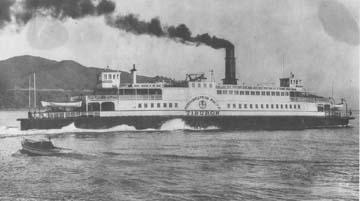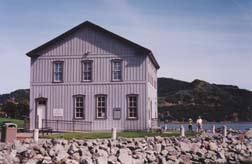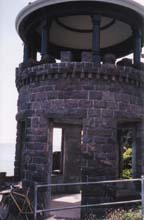 |
| The Tiburon, powered by an
engine Donahue built in his Union Iron Works, was the first ferry built
in Tiburon. Photo courtesy of Belvedre-Tiburon Landmark Society |
As ferry service changed, so did the rail
lines, the smaller lines being absorbed into the Northwestern Pacific Railway
Company. When Peter Donahue died in 1885, just a year and a half after bringing
the railroad to Tiburon, his son James Merven became president of the railroad,
though his reign lasted only 5 years until his death in 1890. The SF & NP
Railroad was then sold, and eventually became part of the Northwestern Pacific.
With Donahue’s SF&NP now alongside rival North Shore Railroad (successor
to Doherty’s North Pacific Coast), and lines north to Humboldt County, the
Northwestern Pacific operated over 400 miles of track between the Bay Area and
the Redwood Empire.
The consolidation brought the end of
passenger trains and ferry service between Tiburon and San Francisco, by 1909.
The Northwestern Pacific passenger terminal shifted to Sausalito, and Tiburon
became the main freight and mechanical terminal. A new ferry was needed to
connect to Sausalito, and the Donahue was revived to serve Tiburon until
the Requa was brought in from Vancouver . Burned, rebuilt and renamed,
the Marin, it linked the towns until buses replaced it in 1933. In 1941,
Sausalito ferry service ceased as the Golden Gate Bridge made it unprofitable,
and passenger train traffic was also waning. San Rafael became the passenger
terminal for Northwestern Pacific in 1942, running only 2 San Rafael-Eureka
passenger trains. Known as the "Eureka Express," the train left
passengers at San Rafael and steamed to Tiburon only for servicing and cleaning.
The run was soon abandoned, and since 1958, there has been no passenger service
south of Willits.
The Tiburon railyard became less important as
repairs were shifted to parent Southern Pacific yards. The last of the machine
shops were closed in 1963. The last train pulled out of Tiburon yards in 1967,
with 8 freight cars unloaded from a Santa Fe barge. This was 83 years after
Peter Donahue’s inaugural excursion aboard the Donahue, which
celebrated the opening of his new rail and ferry line from San Francisco.
Sculptor Douglas Tilden has created a monument to the many crafts of Colonel
Donahue (located at the corner of Bush and Market Streets in San Francisco). It
marks the dawn of an era you can visit at the Tiburon Railroad and Ferry Museum.
 |
| Tiburon Railroad-Ferry
Museum Photo by Nancy Salcedo |
Donahue originally constructed the Tiburon
Railroad-Ferry Museum building in 1884 as the terminal depot. It was then
surrounded by train sheds, a round house, machine shops, offices, and the ferry
slip with a wharf running down both sides. In all, the huge, deep water complex
encompassed more than 60 acres, with 50 buildings. The museum alone now graces
the Paradise Drive waterfront, downstairs depicting the old passenger terminal
station for both trains and ferries, while the upstairs recreates the home of
the railroad agent William Bent and his family. This is one of two surviving
dual-use terminals nation-wide. The museum houses a working model of the old
Tiburon rail yard, and reveals how the local working class lived upstairs. Its
also fun to wander some of the old neighborhoods, like nearby Old Tiburon, to
get a feel for the old days. Tiburon literally sprung up when the train arrived.
Some of the oldest homes date back to this era. Other neighborhoods with
original homes include Belvedere Street, Italian Row, and Community Road.
After exploring the depot, follow the
waterfront east. Beyond the Museum is elephant rock and its public pier, and the
Caprice Restaurant (popular with the locals, and the only restaurant with a
bridge view in Tiburon.) Next begins Old Tiburon, the entrance marked by Lyford’s
Tower, built in 1889 and listed on the National Register of Historic Places.
Many homes in Old Tiburon, also known Lyford’s Hygea, have been re-done beyond
historic recognition, but some do reflect their heritage. The beautiful homes
attest that Tiburon has come a long way since the railroad days. Both Sides
of the Tracks is the title of a book you might want to look over at the new
library downtown. It relays Tiburon’s oral histories. Another is A
Pictorial History of Tiburon.
 |
| Lyford’s Tower was built in
1889 and is listed on the National Register of Historic Places. Photo
courtesy of Belvedre-Tiburon Landmark Society |
The Belvedere-Tiburon Landmarks Society has
done a good job of bringing Tiburon’s rich history to life with the Railroad
Ferry Museum, the historical walking tour, interpretive signs at China Cabin and
Lyford’s Tower, and friendly docents, many of them old-timers, at Old St.
Hilary’s and the depot museum. The shops and restaurants you’ll encounter
are mostly locally run, long-time establishments, many housed in historic
buildings. Indeed, the town has retained many of its old time residents over the
years-If you’re lucky, you’ll meet several while you’re here. The four
outings described here are my favorites, not only because of their obvious
attributes, like a beautiful setting, but because they provide an opportunity to
meet some interesting people and the places they hold dear.
1. The Angel Island Ferry and Angel Island.
Not only can you get to Tiburon by ferry and thrive here for days with no car,
you can, and should, take a ride on the Angel Island-Tiburon Ferry (415)
435-2131- a Tiburon institution and family run business for forty years. If you
want to get on the bay at night, check out their sunset cruise-the San Francisco
Chronicle considers this one of the best kept secrets of the Bay. Different from
the commuter ferry experience, the Angel Island ferry is about being on the Bay
with a colorful host, possibly a member of the founding McDonogh family. The 3rd
(Milt) or 4th (Maggie) generation may be driving your boat. Milt is quite
possibly the oldest captain on San Francisco Bay. A bit of a legend, he is now
on his 13th reissue of his Coast Guard license, which are good for 5 years (that’s
over 65 years.) His stories go back to the railroad days. The first of the
McDonogh’s, Samuel, came to Tiburon when the railroad arrived, opening
McDonogh’s Chowder and Boarding House, catering to railroad workers and
visitors. His son Sam II began the launch, transporting military supplies and
personnel to Angel Island. He ran the marine shuttle between towers of the
Golden Gate Bridge while it was under construction. His son Milt later began
Angel Island
CONTINUE